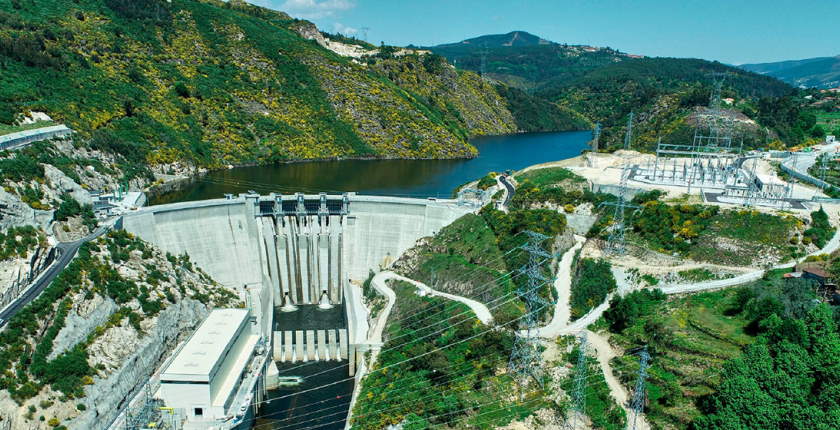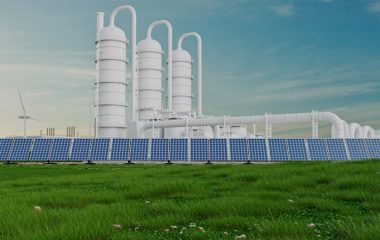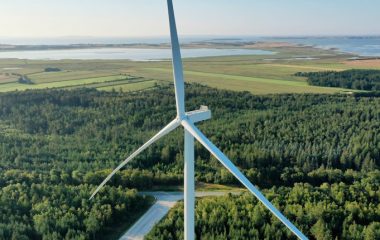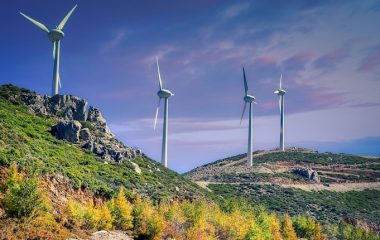
Photo: Iberdrola
Iberdrola inaugurated its pumped storage hydropower plant Tâmega Gigabattery in Portugal and a similar facility was set into motion in Switzerland. They are designed to add over 2 GW in total to Europe’s power storage capacity, which is why such systems are also called water batteries.
Demand and supply in the electrical grid must constantly be kept in balance. The task is becoming more challenging with each wind and solar power plant that is added to the system, as their output depends on weather conditions, which often change rapidly.
Pumped storage hydropower plants are still the only conventional and the most cost-effective technology for balancing electricity systems on a large scale – solutions such as batteries and hydrogen are yet to gain an equal footing in market terms.
Water batteries pump water to the upper reservoir when there is excess electricity and use it to generate power when it is needed
When too much power is produced, a pumped storage hydropower plant sends water from the lower to the upper reservoir, effectively charging the battery. Conversely, when power consumption jumps and, for instance, there is not enough wind and sun, the upper reservoir is emptied and the water passes through turbines, producing electricity.
As a matter of fact, pumped storage systems are also called water batteries. Ordinary hydroelectric units can perform a similar function. They operate when there is a lack of power in the grid. For the storage part, however, they depend on river water to fill their reservoir and they can use it only once.
Iberdrola commissions part of Tâmega Gigabattery in Portugal
The European Union has some of the highest ambitions in the world with regard to climate change mitigation. There is a tight schedule to end the use of fossil fuels almost entirely and reach carbon neutrality. It implies that a vast majority of personal and economic activities that require energy must be electrified and powered by renewable sources.
According to the European Association for Storage of Energy (EASE), the EU will need 200 GW of energy storage by the end of the decade and 600 GW by 2050.
Spain-based Iberdrola has just contributed to the cause by inaugurating its Tâmega Gigabattery in Portugal. At 1.16 GW, it is one of the biggest pumped storage projects in Europe in the last 25 years, the company said.
The Tâmega Gigabattery is scheduled to be upgraded to a hybrid power plant by integrating two wind parks
It is located in the country’s north between Porto and the Spanish town of Ourense. The facility is worth EUR 1.5 billion and it is not yet finished.
The construction of Tâmega Gigabattery began eight years ago. The reservoirs of Gouvães and Daivões and their generators, 880 MW and 118 MW respectively, have been commissioned, while the remaining unit, Alto Tâmega, is scheduled to be completed by June 2024.
The system will have an overall storage capacity of 40 GWh, equivalent to the electricity needs of 11 million residents over 24 hours, Iberdrola said. The Gouvães dam is on the Torno river and the other two are on the Tâmega. Additionally, the utility plans to integrate the complex with two future wind power plants of 300 MW in total, which would make it a hybrid power plant.
Of note, Terna Energy’s Amari project, which has a strategic investment status in Greece, is also planned to be paired with a wind farm.
Nant de Drance pumped storage hydropower plant took 14 years to build
One more giant pumped storage facility recently came online, in Switzerland. It consists of two reservoirs connected with a tunnel, in which the engine room is placed 600 meters underground.
The Nant de Drance system is located in the Canton of Valais in the country’s southwest. The 900 MW water battery with six turbines took 14 years to build.
The world’s largest water battery is under construction in China
The upper reservoir of Vieux Emosson can hold 25 million cubic meters of water, equivalent to 20 GWh. The dam was raised by 21.5 meters to double its capacity. It takes 20 hours to empty it. The plant cost more than EUR 2 billion.
In January, State Grid Corp. of China or SGCC commissioned the first two out of 12 reversible turbine units in the Fengning pumped storage hydropower plant. It said it would be the biggest in the world when it is finished, at 3.6 GW, and with the world’s largest underground powerhouse.
With just above 3 GW in generation capacity, the Bath County pumped storage station in Virginia in the United States is still the largest on the planet.









Be the first one to comment on this article.